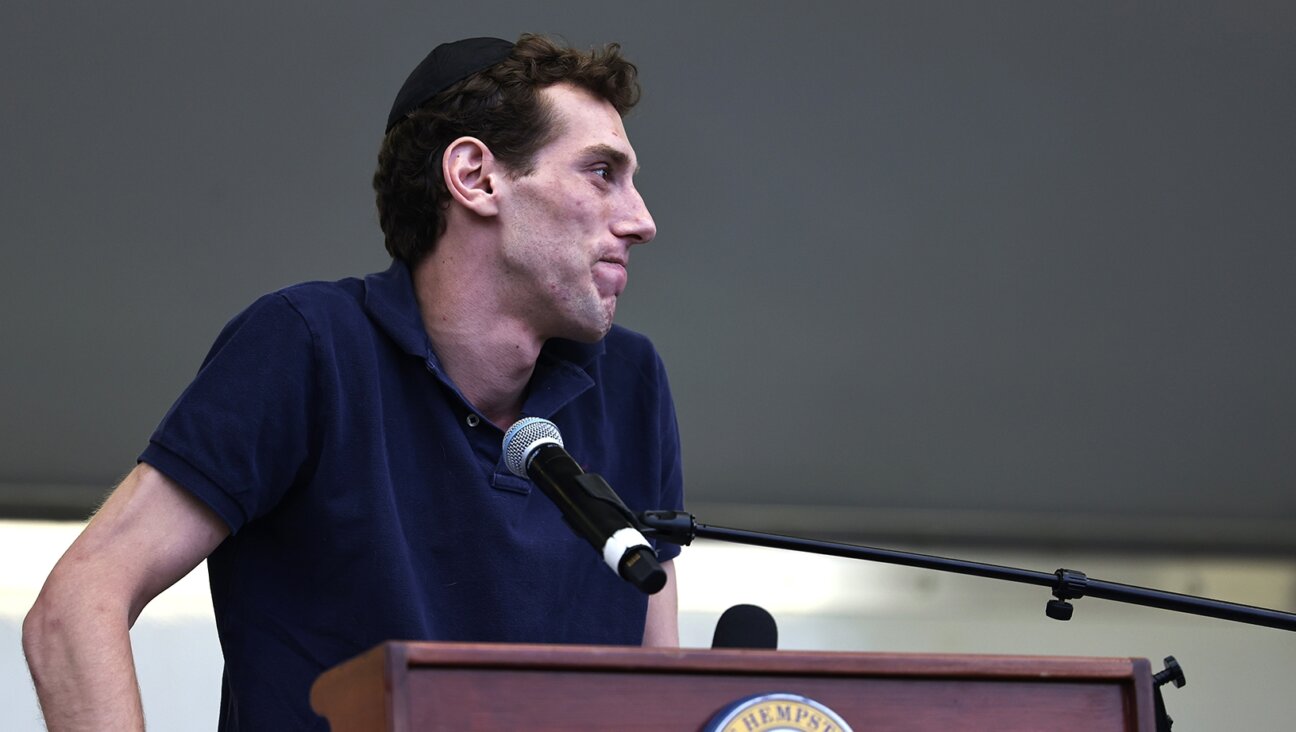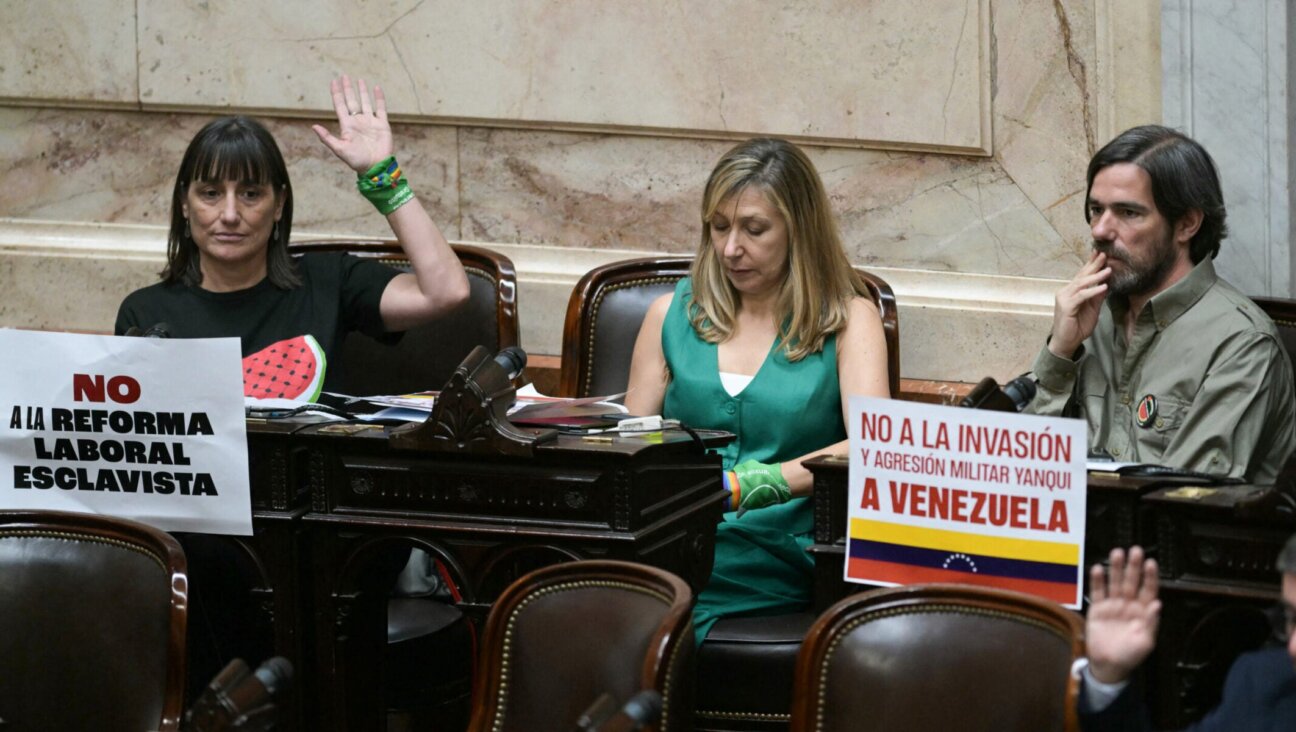From Our Archives: Garment Workers’ New Chief Says ‘We’re Still a Jewish Union’
This article was originally published in the July 20, 2001 edition of the Forward.
Bruce Raynor hasn’t finished moving into his new office, but it already bears his stamp.
The walls and bookshelves are filling up with memorabilia reflecting his past as a 1960s-era leftist and his new status as president of a major international trade union. There are biographies, prominently displayed, of his illustrious predecessors, David Dubinsky and Sidney Hillman, along with well-thumbed paperbacks on Bobby Kennedy and the Vietnam War. On the walls are plaques honoring his years leading brutal textile workers’ organizing campaigns in the South, and huge maps of the United States and Canada, showing regions where his Union of Needle-trades, Industrial and Textile Employees (“Unite” for short) is strongest.
And there, overlooking the conference table, is a group photo of the 1955 championship Brooklyn Dodgers, flanked by portraits of the team’s heroes, Duke Snider, Roy Campanella, Jackie Robinson and Sandy Koufax.
Not that Koufax was a Dodgers hero in 1955. His stardom came a decade later. But — well, you know. This is the garment workers’ union, after all.
“This is still a Jewish union,” Mr. Raynor said. He acknowledged a visitor’s raised eyebrow. Yes, the last Jewish garment workers probably retired before he entered college. That’s not the point. “It’s a Jewish union in terms of its beliefs and ideals. It views itself as much more than wages and benefits. It’s deeply rooted in the traditions of social justice and concern for the least of us. When I say ‘Jewish union,’ that’s what I mean.”
He rapidly ticks off Unite programs that transcend standard unionism. It is, he says, the only union in America that owns its own insurance company, runs its own immigration department, owns massive middle-income apartment complexes, health clinics, even a wholly-owned, 2.8 billion bank that finances strike funds for the labor movement. “And I’m proud to say that striking workers have a better repayment rate than Wall Street.”
Unite was created in a 1995 merger of the two unions remembered in history as bastions of Jewish immigrant activism, the International Ladies Garment Workers Union, or ILGWU, and the Amalgamated Clothing and Textile Workers Union. Once rivals, the two unions were forced to combine in the face of declining membership, largely a result of rising competition from imports. It now numbers some 250,000, smaller than either of its components was a generation ago, but still big enough to be the nation’s 11th largest union.
Mr. Raynor, a popular figure who has led most of the union’s successful organizing drives in recent years — including the bitter, 20-year struggle to unionize J.P. Stevens Co., memorably retold in the 1979 film “Norma Rae” — was elected president in May and took office July 1.
His accession marks a changing of the guard of sorts. The founding generation of union leaders who rose from the shop floor, like Hillman and Dubinsky, gave way in the 1970s to a series of lawyers who led the unions from above. Mr. Raynor is part of generation of baby-boomer activists who came in as shop organizers in the 1970s and are now taking the reins here and in other unions.
Still, he represents a form of continuity in the garment unions. “There’s never been a president of the ILG or the Amalgamated that was not Jewish,” he said. He hasn’t broken the chain.
Raised on Long Island, Mr. Raynor entered Cornell University in 1968 on a General Foods scholarship as a biochemistry major. He switched to labor relations in his sophomore year, inspired by his growing involvement in the New Left and the antiwar movement.
“I saw the labor movement as the only force in society that could confront corporations in America in a realistic way,” he said. “All the rest was just shooting in the wind. Labor had power because it could affect the economy. It could affect people’s lives.”
Then, too, he admits, “I was attracted to the excitement of it.”
He went to work for the textile workers after graduation, first in the education department, then as an organizer in a J.P. Stevens textile mill in North Carolina. He was transferred in 1979 to Atlanta, where he eventually became director of the union’s Southern region. He was elected vice-president of the union in 1981 and executive vice-president in 1993.
Those were difficult years for organized labor. In addition to a precipitous decline in manufacturing jobs, thanks to new technologies that lowered the price of imports, unions were thrown on the defensive during the 1980s by the aggressively pro-business orientation of the Reagan administration. Businesses, emboldened by the new mood, adopted a host of new measures to fight off unionization, which unions were hard-pressed to counter.
In the popular culture of the era, labor’s struggles were largely synonymous with the 1979 Oscar-winning movie “Norma Rae.” Sally Field played a textile worker who tries to organize a union and ends up falling in love with the union’s professional representative, a New York Jewish leftist played by Ron Liebman. The film was a thinly disguised account of the Amalgamated’s J.P. Stevens organizing campaign.
Mr. Raynor denies the persistent rumors in some aging baby-boomer circles that he was the model for the Ron Liebman character. The real woman on whom Ms. Field’s character was based, he notes, fell in love with a different union representative, not him.
Still, life does follow art. Mr. Raynor also ended up marrying a factory worker who is, he volunteers, black. She’s now a social worker. They have five children.
Mr. Raynor said he and his wife have worked out a delicate balance between his active Judaism and her Baptist faith. The children study both religions, and must pick one. “We have a rule in our family,” he said. “You have to have a religion. You can pick which one you want. Right now four of the kids are Baptists and one is Jewish. At different times they’ve been three and two.”
One of his sons is “a six-foot-five, 235-pound college basketball player who’s very Baptist, but he knows more Hebrew prayers than any of the Jewish kids in his school.”
Judaism’s numerical disadvantage in the Raynor family appears to stem in part from the fact that Mr. Raynor quit his synagogue last year, disgusted over a financial feud that forced the rabbi’s resignation. “I thought the congregation turned on itself,” he said. “It’s the first time in my life that I’m not a member of a synagogue.” The worst of it is that his youngest daughter, the one who “is still Jewish,” dropped out of Hebrew school as a result.
“It’s too bad,” he said. “She was a great Hebrew student.”
Mr. Raynor said he continues his Jewish involvement through participation in the labor advisory committee of Israel Bonds. He hopes to use his new union post as a platform to rebuild alliances between the Jewish community and the labor movement.
“You meet so many Jewish people whose parents and grandparents were garment workers and socialist activists and have forgotten where they came from,” he said.
“The labor movement is the largest democratic force in our society. It has the most power for a pro-people agenda. It’s a powerful bully pulpit. And 26% of voters in the last election were from union households. That’s a new high. So I wouldn’t underestimate union influence.”
“There are plenty of strains of idealism and social justice in the Jewish community,” he said. “One of my goals is to bring this issue back to the Jewish community. I would like to see the American Jewish community take ownership of its traditional union roots.”













